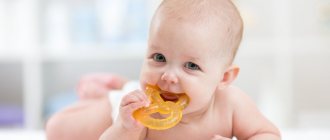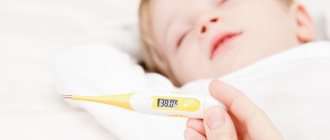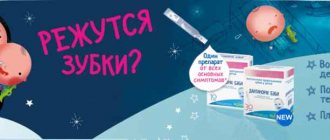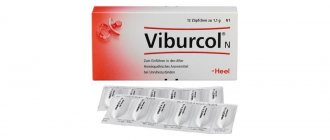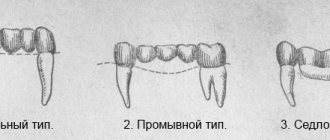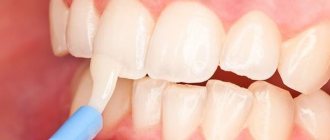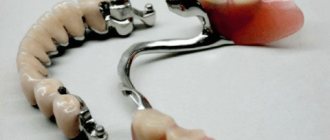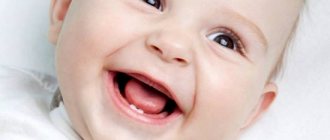The eruption of baby teeth is a process that occurs with a high level of discomfort, sometimes causing genuine suffering for the baby. In addition, it disrupts the routine and deprives not only the baby of sleep, but also his parents. Often, when teething, it is recommended to use the homeopathic drug Viburkol, which is designed to alleviate the symptoms of this important but difficult period.
To understand whether the drug is safe for a child, how to use it and how effective it is, you need to learn more about its characteristics.
Characteristics of the drug
Viburkol is produced by a German pharmaceutical company that has specialized in the development and production of homeopathic remedies for many decades.
Release form
The medicine is presented in the form of torpedo-shaped suppositories, which facilitates rectal administration.
The presence of hard fat allows the process of introducing suppositories to be carried out without the risk of injuring the mucous epithelium of the rectum.
Compound
The composition includes extracts of medicinal plants, which in the dosages used are not capable of causing harmful effects on babies even during the neonatal period. Main components:
- chamomile;
- belladonna;
- plantain;
- nightshade;
- lumbago.
The non-plant substance present in the composition is calcium carbonate, but it is also safe to use.
The substances included in the composition have an anti-inflammatory, analgesic and sedative effect by strengthening the defenses and normalizing impaired body functions.
"Viburkol" - what kind of drug is it?
The drug in question belongs to the class of homeopathic remedies, produced by a German company. These are rectal suppositories, which are often used for young children during the eruption of their first milk teeth. However, this remedy helps relieve similar symptoms of many other childhood diseases.
According to experts in the field of pediatrics, this form of administration, namely suppositories, is the most preferable. This is a painless option for transferring medicinal substances into the body of a small child. Unlike tablets and capsules, suppositories do not provoke a gag reflex, and the active components of the drug are absorbed through the intestines much faster. In addition, “Viburkol” is a product created on the basis of plant components, so the harmful side effects are virtually reduced to zero.
Indications
The decision to start using Viburkol can be made by both the pediatrician and the parent, based on the following symptoms in the baby:
- signs of pain in the gum area;
- a high degree of restlessness or moodiness;
- excessive arousal during the active period;
- difficulty falling asleep or frequent awakenings during sleep;
- a constant desire to touch your cheek, ear or temple with your hand, as this indicates that the pain is radiating to these areas;
- temperature against the background of teething.
Viburkol is prescribed not only when teething is accompanied by an increase in temperature, but also when it is normal.
Using this medication will help reduce itching, pain, and swelling in the area where the new tooth will soon appear. Due to the reduction in edema, the amount of saliva produced in the oral cavity will also decrease due to the increased activity of the immune system, which prevents the occurrence of inflammation in the hyperemic area of the oral mucosa.
Many pediatricians believe that the effectiveness of these suppositories is low in relation to elevated temperatures. The famous children's doctor Evgeny Komarovsky points out that they, like all homeopathic remedies, belong to a group with unproven effectiveness. Nevertheless, tests and the experience of many parents confirm that when using these suppositories, the teething process becomes less painful and all symptoms decrease to a tolerable minimum.
Teething in children: modern concepts
The eruption of baby teeth in children is a routine process that no individual can avoid. This process is determined by both genetic and environmental factors. Theoretically, innervation-induced pressure in the apical part of the teeth induces the process of eruption, which requires long-term adaptation from the periodontal membrane, as well as active movement of the crown follicle, which destroys the overlying bone tissue.
For many years, discussions have continued among representatives of pediatric specialties regarding teething and its impact on the health of infants [1–3]. Therefore, it was even proposed to consider the so-called “teething syndrome in infants,” which has a corresponding reflection in the International Classification of Diseases, 10th revision - ICD-10 (code K00.7) [2]. Apparently, in the coming years it will find its place in ICD-11.
The opinion of the medical community on the issue of the use of special gels that alleviate the main symptoms that often accompany teething, which will be discussed below, seems equally ambiguous.
The appearance of teeth: just the facts
The formation of teeth occurs approximately on the 40th day of embryonic life. The eruption of primary teeth most often occurs in the second half of the first year of life, usually at the age of 6–8 months.
The order of teething in the first year of life is as follows:
- lower middle incisors;
- upper middle incisors;
- upper lateral incisors;
- lower lateral incisors.
In the latest (20th) edition of the Nelson Textbook of Pediatrics, N. Tinanoff (2016) provides the following information about baby teeth:
- lower middle incisors: first signs of calcification (SCC) - 4.5 months of intrauterine development, crown formation (FC) - 4 months, eruption (E) - 6.5 months;
- upper middle incisors: PPK - 3–4 months of intrauterine development, FC - 4 months, P - 7.5 months;
- upper lateral incisors: PPK - 4.5 months of intrauterine development, FC - 5 months, P - 8 months;
- lower lateral incisors: PPK - 4.5 months of intrauterine development, FC - 4¼ months, P - 7 months;
- lower canines: PPK - 5 months of intrauterine development, FC - 9 months, P - 16–20 months;
- upper canines: PPK - 5.5 months of intrauterine development, FC - 9 months, P - 16–20 months;
- first upper molar: PPK - 5 months of intrauterine development, FC - 6 months, P - 12–16 months;
- first lower molar: PPK - 5 months of intrauterine development, FC - 6 months, P - 12–16 months;
- second upper molar: PPK - 6 months of intrauterine development, FC - 10-12 months, P - 20-30 months;
- second lower molar: PPK - 6 months of intrauterine development, FC - 10-12 months, P - 20-30 months [1].
It is quite natural that the timing and order of teething may differ significantly from those given above (the individual characteristics of this process are often genetically determined). To a certain extent, the timing of teething depends on the gender of the child; in girls it usually occurs somewhat earlier and faster.
According to the proposal of A.F. Tour, to calculate the number of baby teeth that a child aged 6–24 months should have, it is necessary to subtract the number 4 from the number of months of life (actual calendar age) [4].
Currently, it is believed that in the process of teething, it is not so much direct perforation of the gum mucosa by crowns that occurs, but rather an increased production of certain hormones in the child’s body, which cause cell death in the gums, freeing up space for teeth.
The review work by I. Kjær (2014) outlines modern ideas about the mechanisms of the process of primary teething in children, and also presents the author’s own hypothesis, according to which the described physiological process depends on three main factors:
- free space in the path of teething;
- lift or pressure from below;
- adaptability (adaptability) of teeth in the periodental membrane [5].
In general, among the many theories and hypotheses (there are about 500 in total) explaining the mechanisms of teething, only four deserve attention: 1) growth of the tooth root; 2) increased hydrostatic pressure in the periapical zone or dental pulp; 3) reconstruction of bone tissue; 4) periodontal traction [6].
In the Russian Federation, explanations for the mechanisms of teething are usually found in the theories of John Hunter (“root” theory), G. V. Yasvoin (“rocket” theory) and A. Ya. Katz (the theory of pressure of a growing tooth on the side walls of the alveoli), as well as I. G. Lukomsky (theory of simultaneous development of tooth and alveolar bone), which readers can familiarize themselves with if they wish.
The crown follicle destroys the overlying bone tissue and thus provides the necessary space along the teething route. This process depends on the state of the ectoderm in the tooth follicle.
The root shield acts as a glandular membrane, the innervation of which creates excess pressure that forces the teeth towards the surface of the shield, periodontal membrane and pulp tissue. As a result of this pressure, the teeth rise in the direction of eruption.
Problematic teething
On the one hand, many pediatricians believe that the teething process does not cause fever or diarrhea. On the other hand, tens to hundreds of articles report hypothermia accompanying teething, bowel disorders and many other symptoms accompanying this physiological process. In general, the medical community recognizes that teething can be accompanied by pain and increased body temperature (hyperthermia) [1].
The so-called “difficult teething” (dentitio difficilis) may be accompanied by local symptoms (swelling/redness/itching of the gums), general malaise, loss of appetite, hypersalivation, rhinorrhea, restlessness and irritability, nausea, regurgitation/vomiting, sleep disturbances, increased body temperature , dyspeptic symptoms, skin rashes, delay or slowdown in weight gain, etc. [7–10].
As indicated by A.L. Zaplatnikov et al. (2018), a key role in the development of various teething symptoms belongs to pro-inflammatory cytokines (in the gingival fluid during primary teething, the concentration of interleukin-1, interleukin-2 and interleukin-8, as well as tumor necrosis factor α, increases) [2].
The presence of symptoms such as hyperthermia, sialorrhea/hypersalivation, sleep disturbances and irritability in children during the first years of life during teething is confirmed by the work of M. Memarpour et al. (2015), S. Massignan et al. (2016), and M. A. Nemezio et al. (2017), and the last two publications used tools and approaches of evidence-based medicine - a systematic review and meta-analysis [11–13].
Since it has been repeatedly demonstrated over the years that the eruption of primary teeth can be problematic and accompanied by pathological manifestations, there is no doubt about the need to treat these symptoms. For this purpose, paracetamol and ibuprofen (oral or rectal dosage forms), some systemic homeopathic remedies (Viburkol, etc.), as well as special children's gels for gums during teething can be used [14–17].
The most convenient to use are topical gels, which are widely used in many countries around the world.
Teething Gels: Possible Ingredients
Currently, about a dozen products for this purpose are simultaneously presented in the pharmacy network of the Russian Federation. If we try to symbolically classify all the currently available gels for gums during teething, then they can be conditionally classified into one of three categories:
1) synthetic gels (with analgesics/anaesthetics); 2) gels based on natural plant extracts; 3) combined gels: synthetic anesthetics combined with natural plant extracts.
The anesthetics in the described gels are most often lidocaine, benzocaine and/or choline salicylate.
Among the antiseptic ingredients of the gels are cetylpyridinium chloride and cetalkonium chloride.
Other components that may be used are polidocanol (a non-ionic detergent) and trometamol (an anti-acidemic agent); these pharmacological agents provide a predominantly local cooling effect when applied to the child's gums.
Dangerous components of teething gum gels
In 2011, the US Food and Drug Administration (FDA) called for the avoidance of any benzocaine-containing products to treat teething symptoms. This recommendation is based on the risk of developing methemoglobinemia in children under the influence of the described anesthetic. Methemoglobinemia is a rare but very serious condition that can sometimes be fatal.
EJ Ip et al. (2018) asked two hundred pharmacists working in 115 pharmacies in the San Francisco Bay Area (USA) to complete a 16-item questionnaire. The majority of respondents (63.0%) were still inclined to recommend benzocaine-containing gum gels for teething infants [18]. Pediatricians have known about the possibility of acute and chronic intoxication with salicylates contained in teething gum gels for more than forty years.
In 2014, the FDA did not recommend the use of lidocaine in teething gels for children. An overdose of lidocaine rubbed into the gums, or if a child swallows too much of it, may cause seizures, severe brain damage, or cardiovascular problems. There are also cases of accidental poisoning of children with lidocaine during its topical use, sometimes with a fatal outcome.
As it turned out, the use of teething gels is accompanied by a potential risk of developing intoxication due to the content of salicylates in them. This, in particular, is reported in the publications of GD Williams et al. (2011), as well as in the latest works of T. Nguyen et al. (2018) and K. E. Hofer et al. (2018) [19–21].
Since 2014 in the UK, the use of oral gels containing salicylates is not recommended for patients under the age of 16 years, which completely excludes such indications for their use as teething in infants. T. K. Oman et al. (2008) demonstrated a case of the development of Reye's syndrome in a 20-month-old child after using a teething gel with choline salicylate [22]. It is believed that this particular case served as the basis for the corresponding recommendations of the British Commission on Human Medicines (CHM). Although representatives of the Medicines and Healthcare Products Regulatory Agency (MHRA) are inclined to believe that the described case is more consistent not with Reye's syndrome, but with acute salicylate poisoning, the recommendation is not to use oral topical gels with salicylic salts acid is retained.
Due to the fact that all anesthetics without exception (benzocaine, lidocaine, salicylates) included in anesthetic gels can pose a danger to the health and life of children, preference should be given to those topical products that do not contain the components listed above, but natural extracts medicinal plants. A similar point of view is shared by T. V. Kazyukova et al. (2015), I. A. Khoshchevskaya (2013), M. G. Lukashevich (2016), E. I. Kleschenko et al. (2017), as well as E. A. Goreva et al. (2017) [7, 9, 10, 23, 24]. M. G. Shchegoleva writes about the preference of protective gels for gums during teething (2015) [25].
Protective gels versus anesthetic gels
One of the newest concepts in recent years is the use of gum gels during teething, which create a protective film at the site of application and do not contain sugar or parabens. Thus, quite recently S. Rosu et al. (2018) presented the results of a pilot randomized trial (open and controlled) carried out by representatives of a number of Romanian and Italian medical institutions. In the study described, a protective gel for gums was used [26].
This gel was used in 27 children (age 3–36 months) for 7 consecutive days; The FLACC system (Face, Legs, Activity, Cry and Consolability Pain Assessment Tool) was used to assess pain. The presence of teething was determined by at least three signs: local pain, swelling, erythema, hypersalivation and deep characteristics of unerupted teeth. Primary symptoms were assessed at baseline and then on days 3 and 7. In addition, the patients' parents recorded daily changes in crying, oral spasms, salivation, local tenderness, swelling and hyperemia of the gums in the charts. The comparison group consisted of 30 children of the same age, in whose treatment a standard industrial gel was used (containing lidocaine, lauromacrogol 600 and chamomile extract); The same research methods were used as in the main observation group [26].
The results of the study made it possible to demonstrate in children of the main group a significant reduction in the severity of pain and swelling of the gums (from the first to the seventh day, p = 0.034), hyperemia (from the first to the third day - p = 0.045, and from the first to the seventh day - p < 0.001 ), which was confirmed by the records of the patients' parents. When assessing the sum of indicators using the FLACC system, the differences between the observation groups were p < 0.005 (in favor of the main group) [26].
As one of the new representatives of protective gels based on natural ingredients available in Russia, one should consider Dentinale® natura, which is an over-the-counter product. Children's gel for gums during teething Dentinal Nature contains the following herbal ingredients:
- natural extract of boswellia/frankincense tree resin (Boswellia serrata);
- natural extract of chamomile (Chamomilla recutita);
- natural extract of aloe/agagae leaf juice (Aloe barbadensis);
- natural extract of saffron (Crocus sativus);
- Sweet orange peel oil (Citrus aurantium dulcis).
All of these components have a pronounced anti-inflammatory, antiseptic and regenerating effect when the described gel is applied to the gums [27]. Boswellia, in addition to the properties described above, also has analgesic properties [28].
Dentinale nature gel, when applied to the gums, forms a protective film, thereby reducing hypersensitivity, inflammation and irritation of the gums (without the use of analgesics). Additional positive characteristics of the product are the absence of sugar and parabens (esters of parabenzoic acid) in its composition.
Apparently, it should be considered that protective gels based on natural plant extracts (Dentinale Natura, etc.) are not just a full-fledged alternative to products for a similar purpose containing lidocaine, benzocaine and/or salicylates, but are significantly superior to them. Protective gels based on natural plant extracts have better tolerability and, most importantly, a better safety profile, and there are no restrictions on their use.
Literature
- Nelson textbook of pediatrics. Kliegman RM, Stanton BF, St Geme III JW et al., eds. 20th ed. Philadelphia. Elsevier, 2016. 3474.
- Zaplatnikov A.L., Kasyanova A.N., Maykova I.D. Teething syndrome in infants: a new look at an old problem // RMJ. 2018; 5 (II): 68–71.
- Sood S., Sood M. Teething: myths and facts // J. Clin. Pediatr. Dent. 2010; 35(1):9–13.
- Tur A. F. Propaedeutics of childhood diseases. 5th edition. L.: Medicine, 1967. 492 p.
- Kjær I. Mechanism of human tooth eruption: review article including a new theory for future studies on the eruption process // Scientifica (Cairo). 2014; 2014: 341905.
- Pediatric therapeutic dentistry. National leadership / Ed. Leontyeva V.K., Kiselnikova L.P.M.: GEOTAR-Media, 2010. 896 p.
- Kazyukova T.V., Radtsig E.Yu., Pankratov I.V. Symptoms of the eruption of primary teeth and possible ways of pharmacological action // RMJ. 2015; 22: 1342–1344.
- Zakharova I. N., Kholodova I. N., Dmitrieva Yu. A., Morozova N. V., Mozzhukhina N. V., Kholodov D. I. Can the physiological process of teething be pathological? // Medical advice. 2016; 01:31–35.
- Lukashevich M. G. The place of drugs based on plant extracts in alleviating the symptoms of painful teething // RMZh. 2016; 18: 1232–1234.
- Kleshchenko E. I., Zhdanova I. A., Lukisha A. N., Krakovets I. V., Smychkova E. V., Kartavtseva A. V. Symptoms of teething in infants: condition or disease? // Kuban Scientific Medical Bulletin. 2017; 24 (4): 78–81.
- Memarpour M., Soltanimehr E., Eskandarian T. Signs and symptoms associated with primary tooth eruption: a clinical trial of nonpharmacological remedies // BMC Oral Health. 2015; 15:88.
- Massignan C., Cardoso M., Porporatti AL, Aydinoz S., Canto Gde L., Mezzomo LA, Bolan M. Signs and symptoms of primary tooth eruption: a meta-analysis // Pediatrics. 2016; 137(3):e20153501.
- Nemezio M.A., de Oliveira K. Mh., Romualdo PC, Queiroz A.M., Paula-E-Silva F. Wg., Silva R. Ab., Küchler E.C. Association between fever and primary tooth eruption: a systematic review and meta-analysis / /Int. J. Clin. Pediatr. Dent. 2017; 10 (3): 293–298.
- Shelkovsky V.I., Studenikin V.M., Pak L.A., Tursunkhuzhaeva S.Sh. Nonsteroidal anti-inflammatory drugs in pediatric practice // Attending Physician. 2011; 11:82–84.
- Studenikin V.M., Tursunkhuzhaeva S.Sh., Shelkovsky V.I. Ibuprofen and its use in pediatrics and child neurology // Issues. pract. pediatrics. 2010; 5 (5): 140–144.
- Studenikin V.M., Akoev Yu.S. Antipyretics/analgesics in modern pediatrics: allopathy and homeopathy // Attending Physician. 2016; 6:7–11.
- Taneja D., Khurana A., Vichitra A., Sarkar S., Gupta AK, Mittal R., Bawaskar R., Sahoo AR, Prusty U., Singh S., Sharma M., Pant R., Singh U., Upadhyay AK, Sehegal S., Patnaik S., Nath T., Manchanda RK An assessment of a public health initiative of homeopathy for primary teething // Homeopathy. 2018; Nov. 20. DOI: 10.1055/s-0038–1673650. .
- Ip EJ, Patel PB, Chi JJ, Shah-Manek B., Lau B. What are pharmacists recommending for infant teething treatment? // J. Am. Pharm. Assoc. 2018; 58(1):79–83.
- Williams GD, Kirk EP, Wilson CJ, Meadows CA, Chan BS Salicylate intoxication from teething gel in infancy // Med. J. Aust. 2011; 194(3):146–148.
- Nguyen T., Cranswick N., Rosenbaum J., Gelbart B., Tosif S. // J. Paediatr. Child Health. 2018; 54(5):576–578.
- Hofer KE, Kaegi S., Weiler S. The acute toxicity profile of a teething gel containing salicylamide in toddlers: an observational poisons center-based study // Clin. Toxicol. (Phila). 2018; 16:1–2.
- Oman TK, Stewart MC, Burns A., Lang TF Topical choline salycilates implicated in Reye's syndrome // BMJ. 2008; 336:1376.
- Khoshchevskaya I. A. Teething: how to help a child? // Medical advice. 2013; 2:36–40.
- Goreva E. A., Petrenko A. V., Babailov M. S. The use of herbal preparations for teething syndrome in children // Health and education in the XXI century. 2017; 19 (10): 71–73.
- Shchegoleva M. G. Comparative assessment of means that facilitate teething // Medicine today and tomorrow. 2015; 2 (67): 142–146.
- Rosu S., Barattini DF, Murina F., Gafencu M. New medical device coating mouth gel for temporary relief of teething symptoms: a pilot randomized, open-label, controlled study // Minerva Pediatr. 2018; Oct. 4. DOI: 10.23736/S0026–4946.18.05360–4. [Epub ahead of print].
- Nutrients, conditional nutrients and antinutrients in neurodietology of childhood (handbook) / Ed. Studenikina V. M. M.: Dynasty, 2021. 184 p.
- Prabhavathi K., Chandra US, Soanker R., Rani PU A randomized, double blind, placebo controlled, cross over study to evaluate the analgesic activity of Boswellia serrata in healthy volunteers using mechanical pain model // Indian J Pharmacol. 2014; 46(5):475–479.
V. M. Studenikin , Doctor of Medical Sciences, Professor, Academician of RAE and MAE
OOO NPSMC "Dream Clinic", Moscow
Contact Information
Teething in children: modern concepts / V. M. Studenikin For citation: Attending physician No. 1/2019; Page numbers in the issue: 7-11 Tags: baby teeth, fever, hypersalivation, itchy gums
Features of application
Viburkol is used only rectally. There is a depression on one side of the candle and a cone-shaped point on the other side. This form allows for easy and painless administration of suppositories.
To perform the insertion correctly, place the index finger in the recess and hold the candle with the middle and index fingers. After this, spread the child’s buttocks and smoothly but quickly introduce Viburkol into the rectum. The candle should completely disappear into the anus.
If everything is done correctly, the baby should not experience pain. Sometimes there is a reflex contraction of the gluteal muscles after injection. To prevent the suppository from being pushed back, the buttocks must be squeezed slightly and held in this position for several seconds.
How to help your child when teething
It is important for parents to remember that the appearance of teeth is a physiological process that every baby goes through. Our goal is to alleviate the symptoms of this process. Various medications and means are used for this.
Teethers can be used as these tools. Among the teethers there are:
- Teether nipples . The most optimal and convenient option for a teether.
- Cooling teethers . There are various companies. We will give preference to Chicco. To use, you must first fill them with water and then place them in the refrigerator. Preference is given to those equipped with a handle. This will prevent the baby's hand from cooling.
- Nibblers . Nibbler is a device for the safe administration of complementary foods to children in the first six months of life. Essentially, it is a mesh or silicone container with holes. Also equipped with a handle. By placing fruit in this device, the baby will also be able to massage his gums.
Teethers can help a child during this difficult period.
These devices can alleviate the child’s condition. In some cases, this is not enough. Then there is a need to use medications. Let's list the rating of the best drugs:
- Gels, ointments for gums. They are means of local therapy. The most popular: Holisal, Kamistad, Kalgel.
- Viburkol suppositories. They are a homeopathic remedy with analgesic, sedative and antipyretic properties.
- When the temperature rises and there is severe pain, Panadol (suppositories) and Nurofen in the form of a suspension are prescribed.
The eruption of incisors and canines in babies is often accompanied by the development of unpleasant symptoms. It is important for parents to remember that this is a physiological process that requires their close attention. Often moms and dads get stressed, not knowing what to do with their child. It is necessary to remain calm and use the means described above to reduce the severity of unpleasant, painful sensations in the baby. If symptoms persist and the actions taken are ineffective, contact your pediatrician. Your doctor will help you deal with this problem. Do not self-medicate; if symptoms of the disease occur, consult a doctor promptly.
How long will it take for it to work?
After the suppository enters the body, rapid absorption of its active substances through the mucous membranes begins. In 10-20 minutes this process is already completed.
The action of the drug occurs in this way:
- After half an hour, the baby should begin to gradually calm down and stop crying. If he did not sleep before this or did not sleep enough, he may soon fall asleep, since the discomfort will no longer disturb him as much.
- To relieve inflammation during teething, more than one application will be needed, since Viburcol in this case has a cumulative effect.
- To reduce a high fever, using this medicine alone may not be enough. Then its administration is combined with the additional intake of another antipyretic.
In mild cases, within a few hours the baby’s condition will improve, and his increased excitability and capriciousness will disappear. If the baby cried a lot, you should not expect that after the first use he will return to normal behavior, but uncontrollable crying may be replaced by slight moodiness, which will not interfere with the wakefulness and sleep patterns, and this will greatly facilitate the period of teething.
What are the disadvantages
- it is an alternative medicine: more suitable as a complementary measure to traditional treatment. Some doctors believe that one can only expect a placebo effect from Viburkol,
- high cost: from 300 rubles. If we take into account that there are only 12 pieces in a package, and when a child has a fever, up to 6-8 suppositories per day are needed, then the expenses will be impressive,
- not the best way to use: after inserting the suppository you need to be at rest for at least 10 minutes, but not all small children agree to this. But children who are already over 2-3 years old may completely refuse this method of administering the medicine, be capricious, and resist.
What are they combined with?
Pediatricians often recommend using Viburkol with other drugs:
- Antipyretics . Suspensions or suppositories are prescribed. This measure will be needed if the temperature does not fall after the administration of Viburkol or rises above 39°C.
- Cooling and anesthetic dental gels . They are applied directly to the gums in small quantities. Such drugs have a temporary effect, but help the baby survive a period of increased discomfort. Please note that teething gels can cause allergies, so you need to be careful when first applying.
- Children's toothpastes with anti-inflammatory effect . These are new pharmaceutical products produced in the form of gels or foam. They are applied using a toothbrush for the first teeth, which is placed on the index finger of an adult. The action of the pastes is aimed at relieving the superficial inflammatory process of the oral mucosa.
What else can you give your baby to expose his condition?
Currently, there is simply no complete analogue of the drug “Viburkol” with the same composition. However, there are plenty of products in pharmacies that doctors allow to be used to alleviate the condition of children as their baby teeth grow. Below are the most popular options:
- based on paracetamol: “Cefekon” and “Efferalgan” - help lower the temperature and reduce pain,
- based on ibuprofen: “Nurofen” and “Ibufen” - also help reduce temperature and block pain,
- gels with anesthetic: “Dentinox” and “Kamistad” - for application to the gums to reduce pain.
If the baby's temperature has risen sharply, not rectal suppositories, but antipyretic drugs in the form of syrups will be more effective. As for local pain relievers, due to the immediate action of lidocoin, they give the desired effect faster than others. If the symptoms are too severe and the temperature exceeds the permissible norms, the child should be immediately shown to a doctor. And remember: any medications, even those based on natural ingredients, should be given to the baby only with the permission of a specialist.
- Elizarova, V.M. Trend in changes in the timing of the eruption of primary teeth in the modern generation of children, 2002.
How to purchase
The drug is sold in pharmacies, you can buy it without a prescription, since the drug does not belong to the category of potent or specific drugs.
Candles are sold in a cardboard box inside foil blisters. The box contains two blisters of six suppositories each. The price of the drug in stationary pharmacies starts from 200 rubles, while in online pharmacies you can buy it for 180 rubles. and higher.
After storage, the product should be stored in a cool place with a temperature below 25°C, since at higher values the solid medical fat begins to melt and the active substances may lose their properties.
Customer Reviews
Anna Grebenyuk, Perm
“I am a mother of two children. Suppositories helped only in the case of the youngest son, and had absolutely no effect on the eldest. But the son immediately changed: he could sleep peacefully, he had an appetite. For my daughter, I additionally lubricated my gums with tooth gel.”
Evgenia Grib, Tver
“Viburkol helped great, but when my son became one year old, he began to be afraid of the very process of inserting the suppository: he struggled with all his might and screamed, so I had to switch to anti-inflammatory toothpastes. But they didn’t soothe the inflamed area so well, because the redness remained the same.”
Causes of elevated body temperature
Fever is a protective-adaptive reaction of the body, which makes itself felt in response to exposure to pathogenic stimuli. Heat causes a restructuring of the body's usual thermoregulation processes, which leads to stimulation of the body's natural reactivity. As a result, the readings on the thermometer are creeping up.vi
Among the reasons that cause a slight increase in readings and do not indicate the development of any disease are the circadian rhythm (the difference between morning and evening numbers on a thermometer can be 0.5-1.0 °C), sports, dancing and any physical activity, as well as slight overheating as a result of exposure to the sun, taking a hot bath or drinking hot (and strong) drinks. In women, levels usually increase slightly in the middle of the monthly cycle, during ovulation. Of course, in all these cases antipyretic drugs are not needed.
But what to do in case of illness, when an adult or child encounters infections that lead to fever? Does VIFERON reduce temperature and to whom and when can it be used?
Reviews from doctors
Sergey Petrovich Olishchuk, pediatrician
“Fortunately, I have not encountered any negative experiences with Viburkol. All components included in the composition can be called safe even for patients in the earliest period of life. They are present in dosages that cannot cause harm or lead to overdose when used wisely. I often prescribe suppositories to reduce pain during teething, but I usually recommend combining them with medications from another group to achieve a lasting effect. Don’t forget about the individual response of the body, which cannot be the same for everyone, so talking about a general reaction and duration of action is not very advisable.”
Denis Anatolievich Krivitsky, head of the private pediatric center
“There are often discussions among doctors about the advisability of prescribing these homeopathic medicines. I know that the composition and action raise many questions, but over the years of my practice I could repeatedly verify that the discomfort when exposed to Viburkol decreases, and this cannot be explained by the placebo effect, since for infants who do not yet understand human speech, the pros and “against” don’t mean anything. I believe that it is their reaction that should be considered as a result. Therefore, I build on these data"
Release form, composition, effect of the drug
"Viburkol" are rectal suppositories (suppositories) of white or yellowish-white color. Sold in packs of 12 pieces. Dispensed from pharmacies without a prescription. According to the manufacturer, the drug contains natural and safe ingredients.
| Composition according to instructions | Ingredient name | Property |
| Chamomilla recutita | Chamomile | Anti-inflammatory, antiseptic. Beneficial effect on the digestive tract and respiratory system. |
| Plantago Major | Plantain | Anti-inflammatory, expectorant, sedative, anticonvulsant. Relieves nervous tension. |
| Pulsatilla pratensis | Lumbago | Calms the nervous system and is a mild natural sleeping pill. |
| Calcium carbonicum | Calcium carbonate | Solves the body's increased need for calcium. As an adjuvant it is used to treat allergic reactions. |
| Solyanum dulcamara | Nightshade | Analgesic, anti-inflammatory, and antifever agent. Therefore, “Viburkol” also helps with fever for children. |
| Antropa belladonna | Belladonna | Reduces the secretion of glands, relaxes muscles and relieves spasms, has a bronchodilator effect. |
| Solid fat | Solid fat | Consists of plant components. Allows the candle to keep its shape and ensures ease and painlessness of use. Makes the candle easily soluble when ingested. |
Attention! The suppositories contain belladonna, which has a lot of positive properties. However, this is a very poisonous plant. Although the component is present in a minimal concentration, not all doctors and specialists consider its use in medications for children acceptable.
